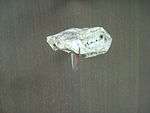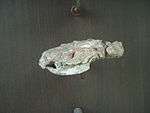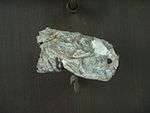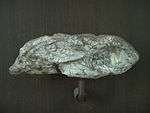Kayentatherium
| Kayentatherium Temporal range: Early Jurassic | |
|---|---|
 | |
| Skull of K. wellesi | |
| Scientific classification | |
| Kingdom: | Animalia |
| Phylum: | Chordata |
| Clade: | Synapsida |
| Order: | Therapsida |
| Suborder: | Cynodontia |
| Family: | †Tritylodontidae |
| Genus: | †Kayentatherium Kermack, 1982 |
| Type species | |
| †Kayentatherium wellesi Kermack, 1982 | |
Kayentatherium is an extinct genus of tritylodontid cynodont that lived during the Early Jurassic. It is one of three tritylodonts from the Kayenta Formation of northern Arizona, United States.
Description




Kayentatherium means "Kayenta (Formation) Beast", and is named for the geological formation in which it was found. Kayentatherium is known from several specimens.[1][2] It was about a meter long, the skull approximately 10 centimetres (3.9 in) in length. The species name honors paleontologist Samuel Welles, who worked with the University of California Museum of Paleontology in much of the pioneering work on the paleontology of the Kayenta Formation.[1]
It was a rather robust animal, and some researchers think it might have been semi-aquatic, adaptations formerly thought to indicate digging habits now interpreted as speciation towards limb-powered swimming.[3]
References
- 1 2 Kermack, D. 1982. A new tritylodont from the Kayenta Formation of Arizona. Zoological Journal of the Linnean Society, 76. 1-17.
- ↑ Sues, Hans-Dieter & F. A. Jenkins. 2006. The Postcranial Skeleton of Kayentatherium Wellesi from the Lower Jurassic Kayenta Formation of Arizona and the Phylogenetic Significance of Postcranial Features in Tritylodontid Cynodonts In: Carrano, Matthew T., Gaudin, T. J., Blob, R. W. and Wible, J. R., Amniote Paleobiology: Perspectivers on the Evolution of Mammals, Birds, and Reptiles: The University of Chicago Press. pp. 114-152.
- ↑ Anusuya Chinsamy-Turan, Forerunners of Mammals: Radiation • Histology • Biology, Indiana University Press, 18/11/2011